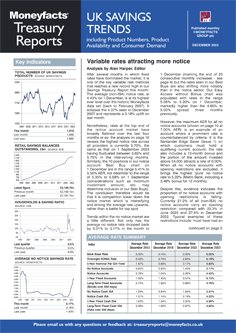Rachel Springall, Finance Expert at Moneyfacts, said:
“The savings market experienced an onslaught of fixed rate cuts month-on-month, with average fixed rates dropping to their lowest levels in almost six months. The average rates across one-year and longer-term fixed bonds and fixed ISAs fell by levels not seen in over a decade. Longer-term fixed bond and ISA rates are experiencing bigger monthly cuts than their one-year fixed counterparts, indeed the average longer-term fixed bond rate fell by 0.26%, the biggest drop recorded since December 2012, and the average one-year fixed bond rate fell by 0.23%, its biggest monthly fall since February 2009.
“The fixed rate cut momentum may well come as disheartening news to savers, but they may be wise to shake any apathy and act quickly to take advantage of the latest top rates. Indeed, the average shelf life of a fixed rate bond fell to 28 days, down from 36 days a month prior. This shelf life is now at its lowest point since July 2023, a time where there was notable rate rise activity on fixed bonds. Between the start of June and July 2023, the average one-year and longer-term fixed bond rates rose by 0.57% and 0.41% respectively, the biggest month-on-month rises seen throughout 2023. Overall, 2023 has been a good year for savers, but it has been largely expected that fixed rates would come down.
“Falling interest rates on savings accounts have had a notable impact on the number of live savings accounts that pay above the Bank of England base rate this month. At the start of November 2023, around 20% of live savings accounts could beat 5.25%, but there are now fewer than 10%. As savings rates drop, it is imperative consumers take time to check their existing accounts and ensure they are being paid a competitive return. If savers locked into a best buy fixed rate bond or ISA six months ago, then they are likely earning more as a guaranteed return than they could get with the latest deals on offer. As it stands, savers will find some of the best returns are on offer with building societies and challenger banks, so it’s worth keeping a close eye on the market and compare deals carefully.”
Rachel Springall, Finance Expert at Moneyfacts, said:
“The savings market experienced an onslaught of fixed rate cuts month-on-month, with average fixed rates dropping to their lowest levels in almost six months. The average rates across one-year and longer-term fixed bonds and fixed ISAs fell by levels not seen in over a decade. Longer-term fixed bond and ISA rates are experiencing bigger monthly cuts than their one-year fixed counterparts, indeed the average longer-term fixed bond rate fell by 0.26%, the biggest drop recorded since December 2012, and the average one-year fixed bond rate fell by 0.23%, its biggest monthly fall since February 2009.
“The fixed rate cut momentum may well come as disheartening news to savers, but they may be wise to shake any apathy and act quickly to take advantage of the latest top rates. Indeed, the average shelf life of a fixed rate bond fell to 28 days, down from 36 days a month prior. This shelf life is now at its lowest point since July 2023, a time where there was notable rate rise activity on fixed bonds. Between the start of June and July 2023, the average one-year and longer-term fixed bond rates rose by 0.57% and 0.41% respectively, the biggest month-on-month rises seen throughout 2023. Overall, 2023 has been a good year for savers, but it has been largely expected that fixed rates would come down.
“Falling interest rates on savings accounts have had a notable impact on the number of live savings accounts that pay above the Bank of England base rate this month. At the start of November 2023, around 20% of live savings accounts could beat 5.25%, but there are now fewer than 10%. As savings rates drop, it is imperative consumers take time to check their existing accounts and ensure they are being paid a competitive return. If savers locked into a best buy fixed rate bond or ISA six months ago, then they are likely earning more as a guaranteed return than they could get with the latest deals on offer. As it stands, savers will find some of the best returns are on offer with building societies and challenger banks, so it’s worth keeping a close eye on the market and compare deals carefully.”











